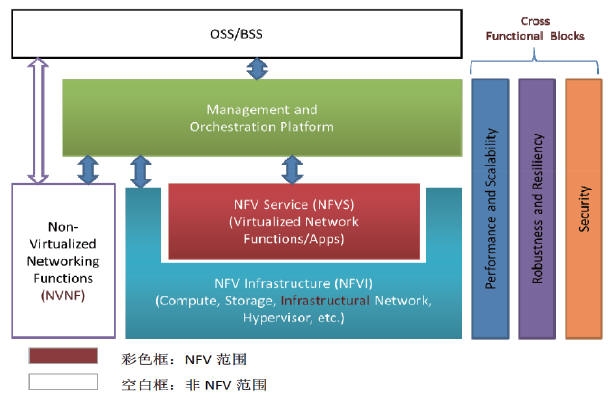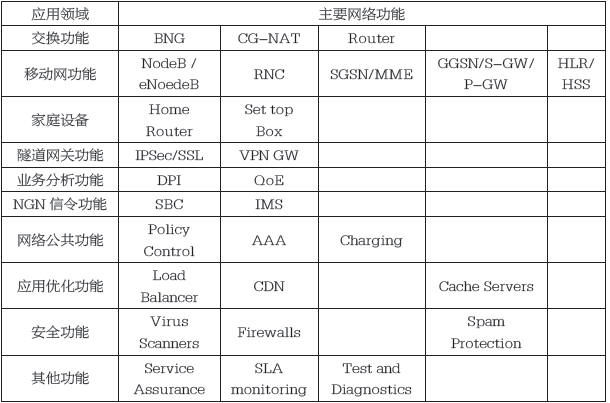Song Xuyi, Oriental Cable Network Co., Ltd. 1.1 Generation of NFV In October 2012, 13 Top operators (AT&T, Verizon, VDF, DT, T-Mobile, BT, Telefonica, etc.) released the NFV (Network Function Virtualization) White Paper for the first time at the SDN and Open Flow World Congress. For the first time, the white paper presents the purpose of NFV: Standard-based large-capacity Server, storage and high-capacity Ethernet switches, build a unified platform, independent deployment of software provided by the irrelevant software Vendor, and application life cycle management (deployment, Capacity expansion and shrinking, etc.) are automated, ultimately achieving network resiliency. In fact, operators propose such a purpose with pain points: The types of dedicated hardware vary, and the number of special hardware is very large. New services are difficult to launch and new dedicated hardware needs to be introduced. It is difficult for multiple manufacturers to connect and exchange existing networks. And this pain point also exists in the radio and television network. Therefore, the biggest attraction of NFV is that operators reduce costs, improve management, maintenance, network and service deployment efficiency, energy conservation, and the potential for openness and innovation in the future. As shown in Figure 1. 1.2 NFV range From the architectural point of view, the scope of NFV is very broad, mainly including infrastructure (computing, storage, networking, virtualization), NFV services (ie, software components separated by hardware and software), and upper management and scheduling platforms. . as shown in picture 2. From an application perspective, NFV covers almost all wired and wireless network functions, including control plane functions and data plane functions. NFVISG has defined nine application scenarios including CDN, home gateway, core network & IMS, and mobile base stations. It can be said that the NFV function combination is flexible and adaptable, and can be arbitrarily combined according to the needs of functional locations, and different network locations can be flexibly deployed. As shown in Table 1. 2.1 NFV Progress The current overall progress of NFV is slow. It was originally planned that before the third meeting of NFV, the four global documents of NFV scenarios, requirements, E2E architecture, and terminology would reach a stable draft state, and operators would be fully guided and fully promoted, and would not be able to do so. . There is little controversy regarding the scenarios and requirements. The main controversy lies in the E2E architecture document, especially the software architecture (combination, deconstruction, componentization) and management architecture. 2.2 NFV advancing attitude In essence, for the NFV attitude, operators and IT manufacturers are more active, and CT manufacturers maintain a follow-up attitude. However, in addition to the general direction of virtualization, operators have different divergence on specific technical issues, and even need to be replaced by Don Clark, who is more capable of coordination, to replace the chairman of the operator council to control the situation. IT equipment manufacturers represented by Intel, HP, and Juniper promoted strong NFV willingness, but lacked a deep understanding of telecommunication networks and solved difficulties by promoting open source. Traditional mainstream CT manufacturers have doubts about the future profit model and respond negatively to the standardization of NFV. Ericsson and NSN are passively watching. Although Huawei and AL actively participate in the process, they do not really want to promote NFV. Only NEC actively contributes. 2.3 NFV Open Source Road Open source is an important means to realize NFV. An important goal of NFV is "componentization." Each component can be purchased independently and independent of each other. The standardization of each component will become the key to the success of NFV; OpenStack may become an NFV infrastructure. The factual standards of components make MANO (Management and Collaboration) the focus of NFV standardization. Whether Alcatel will promote Open Source Cloudify as a core component of NFV MANO, which will enable MANO to achieve standardization through open source, which is a follow-up concern. Focus. In order to cope with the pressure of capital and industrial change, cloud computing and NFV based on it have become the development strategies of major operators. SDN and NFV have undoubtedly far-reaching implications for SDN cable TV network operators. For example, after the deployment of SDN and NFV, the cable TV infrastructure network has become a part of the “cloudâ€, and cable TV network operators can use the network to In the form of "network as a service", the network is flexibly leased to other cable network operators, telecom operators, and virtual operators. Because NFV emphasizes the virtualization of network products, what kind of business is suitable for virtualization becomes the key to NFV implementation strategy. First, desktop, OA and other office management cloudization, customer service and business system desktop clouding, using thin terminals instead of PC, computing, storage, network resource pooling, all application and desktop resources required by the unified layer I, simplify operation and maintenance , improve resource utilization. Secondly, business support systems such as OSS, BSS, and BI are clouded to break down the application chimney, make use of existing network equipment, pool resources, deploy x86 blade clusters, and deploy distributed storage mode to support multi-tenancy; to reduce costs and respond to Big data processing requirements. In the end, we are clouding our core business. However, how to ensure system performance and reliability in the cloudization process is a long-term legacy of the current network. How multi-vendor and multi-class IT equipment is compatible is an issue that we need to explore further. 4.1 Performance Challenges Since NFV uses industry-standard hardware (ie, avoiding any proprietary hardware, such as an acceleration engine), the issue of degraded performance has to be considered. The challenge is how to reduce the performance as much as possible through virtualization technology and modern software technology. 4.2 The challenge of stability Managing and scheduling a large number of virtual appliances on different vendors' hardware and hypervisors must ensure that the stability of the network is not affected. In particular, when virtual functions need to be migrated to new hardware, it is especially important to ensure the stability of the network when a hardware or software failure occurs that requires reconfiguration. 4.3 System Integration Challenges After software componentization, how do these different functions, even modules from multiple vendors, are integrated into effective network functions? This is an important emerging issue. Therefore, the software integration service becomes a new important opportunity. Integration services involve multiple vendors, multiple tenants, and multiple levels. Smart Shelf Edge Led Display,Shelf Led Display,Display Shelf Lighting,Led Shelf Display ShenZhen Megagem Tech Co.,Ltd , https://www.megleddisplay.com
Keywords: NFV; cloud computing; network function virtualization
1 NFV Background Overview 
figure 1 
figure 2 
Table 1
2 Status of NFV
3 NFV application development analysis in the field of broadcasting and TV
4 NFV Challenges in Broadcasting and TV Industry